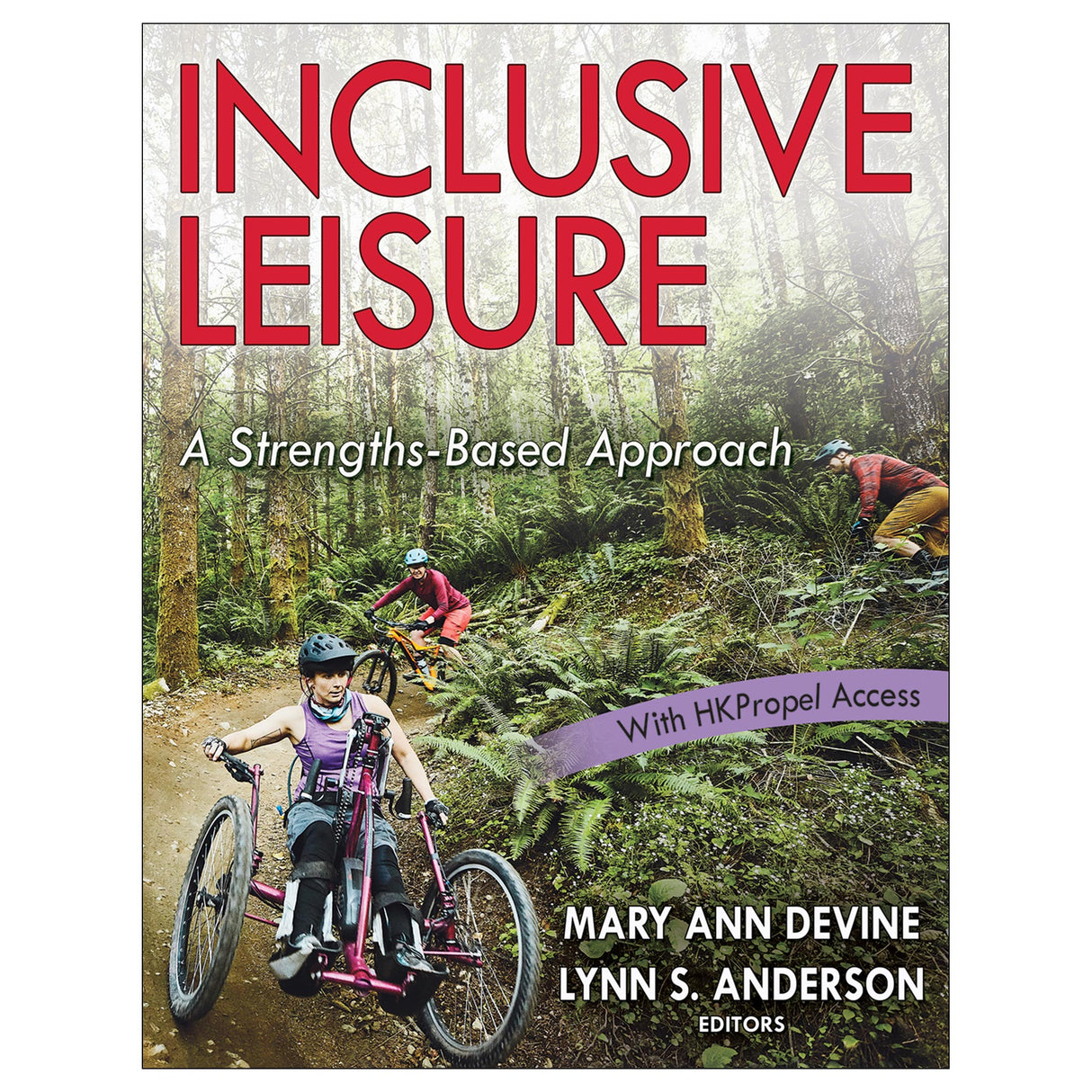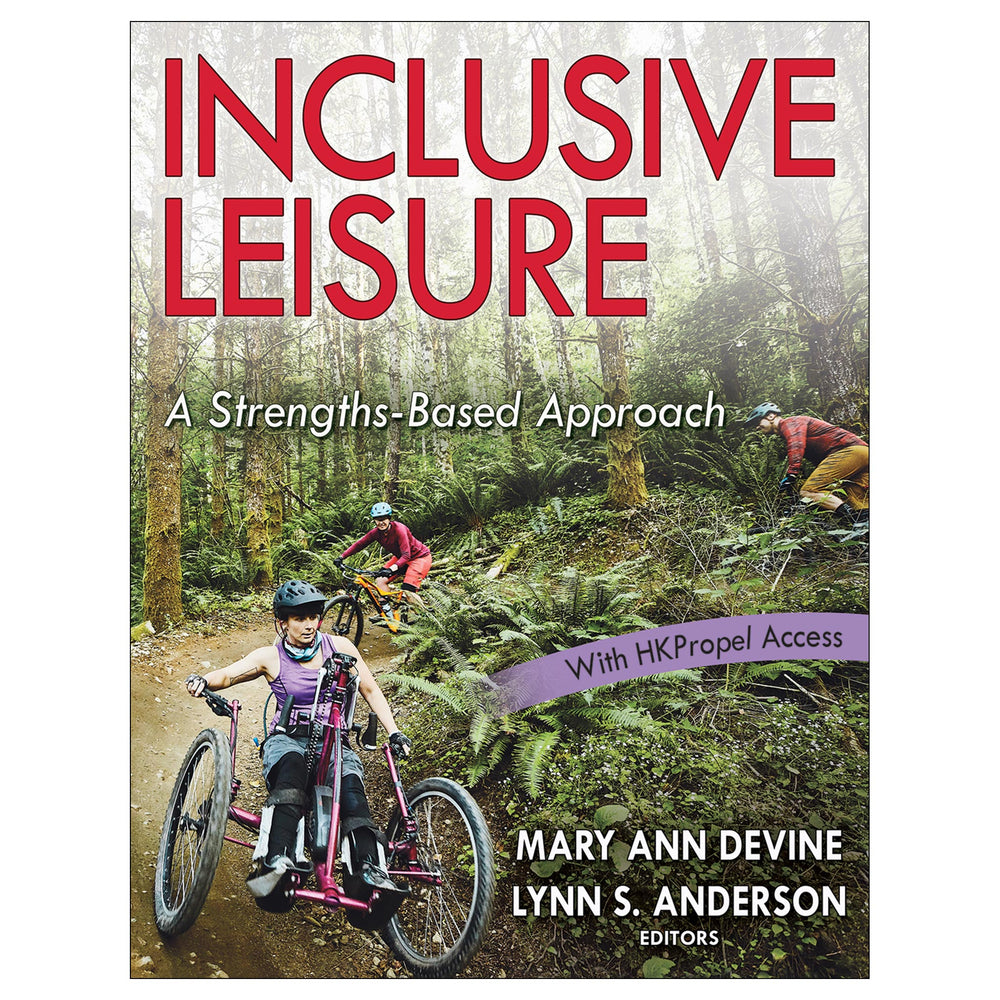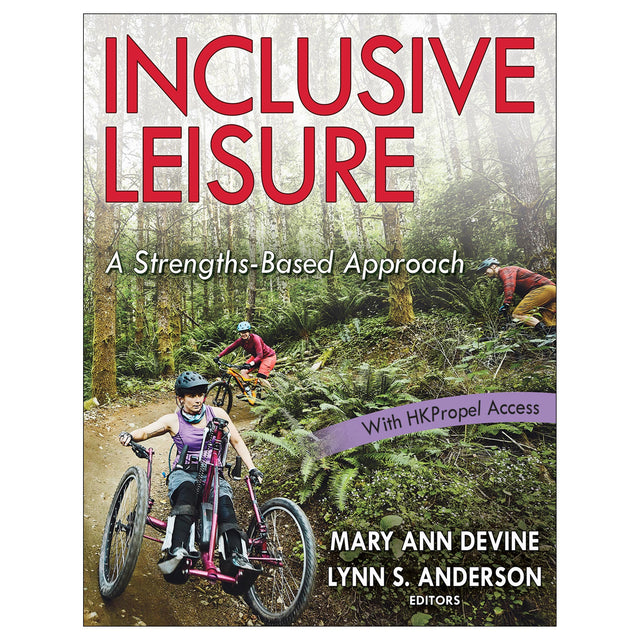Inclusive Leisure With HKPropel Access
A Strengths-Based Approach
Author: Mary Ann Devine, Lynn Anderson
$159.95 CAD
Inclusive Leisure delivers foundational content to help readers understand inclusion and applies this knowledge to practical and applied scenarios. Grounded in a strengths-based approach, which focuses on a person’s abilities rather than their limitations, the comprehensive text moves beyond programming and service delivery by exploring how inclusivity can be applied to administrative practices, organizational philosophy, personnel practices, infrastructure design, community relations, marketing, and more.
Throughout the text, pedagogical aids such as learning outcomes, chapter summaries, and reflection questions help students retain and apply knowledge. Inclusive Leisure also includes the following features to enhance student engagement:
- Professionals in Action sidebars offer a real-world look at the common issues and inclusive solutions that have been employed by professionals in the field.
- Spotlight on Inclusion sidebars highlight leisure programs that are successfully practicing inclusion in a variety of settings.
- Global View on Inclusion sidebars illustrate the work of international organizations that are committed to spreading inclusive practices around the globe.
- Online learning tools delivered through HKPropel include learning objectives, summaries, and website links for each chapter.
Inclusive Leisure asserts that disability is simply part of the human condition, that the strengths and abilities of people with disabilities must be at the forefront of inclusion, and that access to inclusive leisure is a matter of social justice and a critical professional practice. By learning theoretical and legal foundations, building on that knowledge with a multitude of applied elements, and establishing their practice in a strengths-based approach, students will be well prepared to create inclusive leisure environments and programming.
Note: A code for accessing HKPropel is included with all print books.
Audience
Undergraduate and graduate recreation and leisure students.Chapter 1. Introduction to Inclusion
Mary Ann Devine and Lynn Anderson
What Is Inclusion?
Key Definitions
Philosophy and Culture of Inclusion
History of Inclusion
Inclusive Versus Specialized Programs
The Future of Inclusion
Summary
Chapter 2. Introduction to the Strengths Approach
Lynn Anderson
What Is the Strengths Approach?
The Ecological Perspective and the Social Model of Disability
Principles Guiding the Strengths Approach
Inclusion and the Strengths Approach
Summary
Chapter 3. Foundational Principles of Inclusion
Lynn Anderson
Principles: A Beacon to Best Practices
Important Inclusion Principles
Applying the Principles to Practice
Summary
Chapter 4. Theoretical Foundations of Inclusion
Mary Ann Devine
Ecological Theory
Social Identity Theory
Contact Theory
Social Construction Theory
Self-Determination Theory
Summary
Chapter 5. Legal Foundations of Inclusion
Katherine Hunt Thomas
Disability Rights Laws in the United States
Global Disability Rights Laws
Summary
Chapter 6. The People We Serve
Lynn Anderson
Variations in the Human Condition
Meanings of Disability
Disability Is a Functional Variation in the Human Condition
People With Disabilities Are People First
Summary
Chapter 7. Overview of the Inclusion Process
Mary Ann Devine and Lynn Anderson
A Review of Fundamental Approaches to Inclusion
Inclusion Concepts
Inclusion Process Models
Putting Models Into Action
Summary
Part II. Best Practices in Inclusion
Chapter 8. Inclusive Communication
Lynn Anderson and Vicki Wilkins
Person-First and Identity-First Language
Communicating Clearly With Plain Language
Wayfinding and Accessible Signage
Communicating for All: Alternative Forms of Communication
Communicating Electronically: Web and Digital Accessibility
Summary
Chapter 9. Best Practices in Physical Inclusion
Jennifer Skulski
The Physical Environment and Standards Development
New Construction Versus Existing Facilities
Functional Impairments and Building Blocks for the Accessibility Standards
Scoping and Technical Provisions Within the Accessibility Standards
Access to Parks and Recreation Facilities
Universal Design: Beyond Minimum Standards
Summary
Chapter 10. Best Practices in Administrative Inclusion
Tracey Crawford and Andrea Griffin
Agency Vision, Mission, and Values
Advisory Groups and Community Outreach
Planning for Inclusion
Financial Aspects of Inclusion
Marketing
Partnerships
Staffing
Inclusion Point of Contact
Staffing Inclusive Services
Inclusive Policies and Procedures
Evaluating Inclusion Services
Summary
Chapter 11. Best Practices in Inclusive Programs and Services
Lynn Anderson and Carla Kress
Bridging the Gap Model
Registration and Individualized Assessment
Support Services
Adaptations, Modifications, and Accommodations
Implementation, Monitoring, and Evaluation of Inclusive Services at the Individual Level
Advocacy for Inclusion
Summary
Part III. Application of Inclusion Best Practices in the Field
Chapter 12. Inclusion in Sport
Patti Craig, Bob Barcelona, Semra Aytur, Jess Amato, and Jill Gravink
A Transdisciplinary Perspective to Conceptualize Inclusion in Sport
A Big-Picture Overview of the Adaptive Sport Sector
What Is Inclusion in Sport?
Advancing Disability Rights Through Inclusive Sport
Global Sport Initiatives
Summary
Chapter 13. Inclusive Fitness and Physical Activity
John Foley, Nienke Dosa, Stephanie Field, and Mary Ann Devine
A Strengths Approach to Fitness and Physical Activity
Social Justice, Environmental Justice, and Inclusive Physical Activity
Leisure Constraints Theory
Assessing Accessibility in Fitness Facilities
Best Practices in Inclusive Fitness and Physical Activity
Summary
Chapter 14. Inclusive Aquatics
MaryBeth Pappas Baun
Benefits of Participation in Aquatics
Successful and Rewarding Programs
Accessibility Features of Aquatic Environments
Inclusion and Safety in Aquatic Environments
Aquatic Fun and Fitness
Summary
Chapter 15. Inclusive Playgrounds
Marnie Norris and Diane Scanlon
Design Considerations for Inclusive Playground Elements
Inclusive Playground Design Considerations for Site Planning
Additional Inclusive Play Considerations
Building a Stakeholder Base for Sustainable Inclusive Playgrounds
Social Inclusion Programs That Activate the Inclusive Playground
Summary
Chapter 16. Inclusive Camps and After-School Programs
Linda Heyne
Camp and After-School Programs
Unique Characteristics of Camp and After-School Programs That Support Inclusion
Barriers to Inclusion in Camp and After-School Settings
Best Practices
Staff Training
Summary
Chapter 17. Inclusive Outdoor and Adventure Activities
Tim O’Connell and Sarah Connolly
What Are Outdoor and Adventure Activities?
The Process of Outdoor and Adventure Activities
Outcomes of Outdoor and Adventure Activities
Constraints to Participation
A Strengths Approach to Outdoor and Adventure Activities
Trauma-Informed Outdoor and Adventure Activities
Anti-Oppressive Practice in Outdoor and Adventure Activities
Summary
Chapter 18. Inclusive Arts
Sarah Ory and Mary Ann Devine
Why Arts Are Essential
Inclusive Arts From a Strength-Based Approach
Inclusive Arts
Universal Design for Inclusive Arts
Social Justice in Inclusive Arts
Summary
Chapter 19. Inclusive Travel and Tourism
Mary Ann Devine
Fundamentals of Travel and Tourism
Types of Travel and Tourism
Global Perspectives of Inclusive Travel and Tourism
Inclusive Tourism
Inclusion Considerations in Travel and Tourism
Summary
Chapter 20. Inclusive Special Events and Festivals
Mary Ann Devine
Nature of Festivals
Importance of Creating an Inclusive Special Event and Festival
Event/Festival Planning
Entertainment and Performances
Marketing and Communication
Budgeting
Human Resources
Evaluation
Summary
Chapter 21. Inclusive Volunteering
Kimberly D. Miller and Brent D. Wolfe
What Is Inclusive Volunteering?
Why Inclusive Volunteering?
Best Practices in Inclusive Volunteering
Summary
Chapter 22. Inclusive Clubs and Organizations
Lynn Anderson
Overview of Clubs and Organizations
Importance of Inclusion to Clubs and Organizations
Best Practices in Inclusive Clubs and Organizations
Summary
Chapter 23. Inclusive Recreation Beyond Disability
Mary Breunig
Dominant Cultural Paradigm
Historically Marginalized Individuals and Communities
Language Matters: Key Definitions
Toward a More Just View of Recreation and Leisure
Summary
Appendix A. Disability Laws and Acts in English-Speaking Countries Around the World
Appendix B. Inclusive Policy Statements
Lynn S. Anderson, PhD, is a distinguished service professor at State University of New York at Cortland, where she also serves as the founding director of the Inclusive Recreation Resource Center. She has served as chairperson of the recreation, parks, and leisure studies department and coordinator of the online therapeutic recreation graduate program, a program she developed. Her research interests include strengths-based approaches in therapeutic recreation and inclusion in recreation and therapeutic recreation services. She has written three textbooks and numerous book chapters and research articles, and she has delivered professional presentations and workshops on the international, national, regional, state, and local levels. Anderson currently serves on the editorial board for Therapeutic Recreation Journal. She is a fellow of the Academy of Leisure Sciences as well as a distinguished fellow of the National Academy of Recreational Therapists.
All ancillaries are free to adopting instructors through HKPropel.
Instructor guide. Includes chapter summaries, lecture aids, activities, essay topic ideas, demonstrations or guest speaker ideas, and tips for presenting important key concepts.
Test package. Contains more than 500 questions in true-false, fill-in-the-blank, essay and short-answer, and multiple-choice formats. The files may be downloaded for integration with a learning management system or printed for use as paper-based tests. Instructors may also create their own customized quizzes or tests from the test bank questions to assign to students directly through HKPropel. True-false and multiple-choice questions are automatically graded, and instructors can review student scores in the platform.
Presentation package. Features more than 280 PowerPoint slides of text, artwork, and tables from the book that can be used for class discussion and presentation. The slides in the presentation package can be used directly within PowerPoint or printed to make handouts for students. Instructors can easily add, modify, and rearrange the order of the slides.
Instructors also receive access to all student materials in HKPropel. For Inclusive Leisure, this includes learning objectives, summaries, and website links for each chapter.





